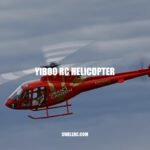Flying Remote Control Planes: Tips, Regulations, and Troubleshooting
Remote control planes, often referred to as RC planes, are a popular hobby enjoyed by many people around the world. Over the years, advancements in technology have made it easier for individuals of all experience levels to fly remote control planes. Flying remote planes is a unique and thrilling experience that can help individuals to relieve stress and spend time outdoors. The feeling of flying a remote plane is incomparable to anything else and can be a great way for individuals to spend time on their own or with friends and family. While it may seem daunting at first, with some practice, anyone can learn to fly a remote control plane. However, it is important to understand which type of plane is best for the individual’s experience level and to learn about safety precautions and FAA regulations before taking off. In this article, we will explore what flying remote planes entails, how to get started, the types of planes and the equipment needed, FAA regulations, troubleshooting common problems, and tips for successful flights.
Types of Remote Control Planes
There are different types of remote control planes, and it’s important to choose one that best suits the individual’s experience level.
- Fixed-wing planes
- Helicopters
- Gliders
- Multirotor aircraft (drones)
Fixed-wing planes are the most common type of remote control plane and come in various sizes, from small foam models to large gas-powered planes. They operate similar to traditional airplanes and require a runway for takeoff and landing. Helicopters, on the other hand, have rotors instead of wings and are better suited for indoors or small outdoor spaces. Gliders are lightweight and are designed to ride on air currents with no engine. Multirotor aircraft or drones are becoming increasingly popular and are a great option for aerial photography or outdoor activities.
When deciding on the type of remote control plane, individuals should consider their experience level, the environment they will be flying in, and their intended purpose for the plane. Researching different types of planes and reading product reviews can also be helpful in making a decision. Websites such as HobbyKing, HorizonHobby, and Amazon offer a variety of remote control planes and are a great place to start for those looking to purchase their first plane.
What are remote controlled aircraft called?
Remote controlled aircraft are commonly referred to as “drones” or “unmanned aerial vehicles” (UAVs). They are typically used for recreational purposes, aerial photography and videography, search and rescue missions, agricultural surveying, and more. Some popular drone brands include DJI, Parrot, and Holy Stone. There are also websites such as DroneDJ and Drone Rush which provide reviews, news, and information on the latest drone products.
Getting Started with Flying Remote Planes
Before taking to the skies with a remote control plane, there are some necessary steps to take.
- Choose a beginner-friendly plane
- Read the instruction manual carefully
- Find a safe and open flying space
- Check the weather forecast for wind and precipitation
- Charge the plane battery and confirm the remote’s batteries are fresh
It’s important to choose a beginner-friendly remote control plane to minimize the risk of crashes and frustration while learning to fly. The instruction manual should be read carefully to ensure the individual is familiar with the plane and its controls. Finding a safe and open space to fly is essential for both the pilot’s safety and the safety of others. Checking the weather forecast for wind and precipitation can also help determine if flying conditions are favorable.
Table 1: Beginner-Friendly Remote Control Planes
| Product | Description | Price |
|---|---|---|
| GP Toys S916 Easy to Fly RC Plane | Durable EPP foam construction with gyro stabilization for smooth flights. Suitable for beginners and includes a controller, battery, and charger. | $55.99 |
| Banggood Volantex Phoenix V2 RC Plane | Ready-to-fly foam-based plane with built-in stabilizer system, easy to control, and comes with a remote control, battery, and charger. | $119.99 |
| Horizon Hobby HobbyZone Sport Cub S2 RC Plane | Ultra micro-sized remote control plane that is easy to fly and features durable EPO construction and SAFE technology. | $129.99 |
Websites such as HobbyKing and Amazon offer a wide range of beginner-friendly remote control planes. In addition, some hobby shops offer classes or instruction on how to fly a remote control plane for those who would like additional guidance.
How do you learn to fly a remote control plane?
Learning to fly a remote control plane can be a fun and rewarding experience. Here are some basic steps on how to get started:
| Step | Description |
|---|---|
| 1 | Choose a suitable remote control plane – look for a beginner-friendly model with a good instructor mode to help with learning the basics. |
| 2 | Find an open space – find a spacious park, field or flying club that allows remote control planes to fly. |
| 3 | Get some resources – search for useful videos online on Youtube or purchase an instruction book or a beginner’s kit. |
| 4 | Practice, practice, practice – start practicing basic flying techniques, like taking off, landing, and flying in different directions. Don’t get disheartened with the initial crashes as they are part of the learning phase. |
Here are some websites that may help with learning to fly a remote control plane:
- www.rc-airplane-world.com – a website for beginners in remote control planes.
- www.flitetest.com – a website with information on building remote control planes.
- www.horizonhobby.com – a website to purchase remote control planes along with the equipment and skills to fly them effectively.
Once the individual has gained some initial experience flying a remote control plane, there are tips to follow to ensure enjoyable and successful flights.
Adjusting to different flight conditions is important, for example, flying in windy conditions may require different adjustments to keep the plane stable. Checking for obstructions before flying, such as trees, buildings, or powerlines, can help avoid potential collisions. Making sure the plane’s battery is fully charged before flight and bringing spare batteries if possible can prevent the frustration of cutting flights short. Using a pre-flight checklist to ensure everything is in order can help prevent preventable accidents.
Practicing basic maneuvers, including turns, climbs, and descents, can help the pilot improve control and get comfortable with the plane’s capabilities. Additionally, websites such as HobbyKing offer instructional videos and articles on how to improve remote control plane flying skills.
Table 2: Recommended Websites for Remote Control Plane Enthusiasts
| Website | Description |
|---|---|
| HobbyKing | Offers a wide range of remote control planes and accessories, as well as video tutorials and articles on plane selection and flying techniques. |
| Flite Test | Provides instructional videos, articles, and forums for remote control plane enthusiasts of all skill levels. |
| Amazon | Offers a variety of remote control planes, kits, and accessories, as well as customer reviews for informed purchase decisions. |
In conclusion, following these tips and using resources such as instructional videos and online communities can help make remote control plane flying an enjoyable and rewarding hobby.
How can I get better at flying RC planes?
If you want to get better at flying RC planes, here are a few tips to follow:
- Start with a slower plane with a stable trainer design before moving on to more advanced or faster planes
- Practice regularly and gradually increase your skill level
- Join a local RC club where experienced pilots can offer advice and guidance
- Watch tutorial videos and read articles on RC plane flying techniques
- Invest in a good quality simulator to practice flying without the risk of damaging your actual RC planes
Additionally, there are a number of websites and products available to help beginners improve their RC plane flying skills, including:
| Website/Product | Description |
|---|---|
| RCGroups.com | Online forum with a wealth of information on RC planes, including tips and tricks for beginners |
| RealFlight RC Simulator | A popular and highly-reviewed RC plane simulator that allows you to practice flying on your computer |
| Flight School by Flite Test | A series of online courses that offer in-depth instruction on everything from building your own RC plane to advanced flying techniques |
FAA Regulations for Remote Control Planes
Before flying a remote control plane, it is important to be aware of the Federal Aviation Administration’s (FAA) rules and regulations for flying unmanned aircraft systems.
- Register the drone with the FAA if it weighs more than 0.55 pounds and less than 55 pounds
- Do not fly near airports or other aircraft
- Fly at or below 400 feet above ground level
- Keep the drone within visual line-of-sight at all times
- Do not fly over people or vehicles
- Do not fly in adverse weather conditions such as high winds or fog
Not following these rules and regulations can lead to fines and other penalties, as well as safety hazards for the public and other aircraft. It is also important to note that state and local laws may also apply, so it is important to research and follow any additional regulations in the area where the remote control plane is being flown.
The FAA website provides a wealth of information on the rules and regulations for drone flying. Additionally, websites such as Know Before You Fly and UAV Coach provide resources and information on drone regulations and safe flying practices.
Table 3: FAA Rules and Regulations for Drone Flying
| Rule/Regulation | Description |
|---|---|
| Registration | Drones weighing more than 0.55 pounds and less than 55 pounds must be registered with the FAA |
| Airports | Do not fly within 5 miles of an airport without prior approval from air traffic control |
| Altitude | Do not fly above 400 feet above ground level |
| Visual Line-of-Sight | Keep the drone within visual line-of-sight at all times |
| People/Vehicles | Do not fly over people or moving vehicles |
| Weather Conditions | Do not fly in adverse weather conditions such as high winds or fog |
In conclusion, awareness of FAA regulations and safe flying practices is crucial for the safety of the pilot and the public. Resources such as the FAA website and other drone regulation websites provide valuable information and guidelines for drone flying.
Do I have to register my remote control airplane with the FAA?
Yes, if your remote control airplane weighs more than 0.55 pounds (250 grams), then you are required to register it with the Federal Aviation Administration (FAA). Failure to register can result in hefty fines. To register, visit the FAA’s official website at www.faa.gov/uas/registration. The cost is $5, and the registration is valid for three years. Make sure to label your aircraft with the registration number provided.
Troubleshooting Common Problems while Flying Remote Planes
While flying remote control planes, it is common to encounter problems such as signal loss or crashes. Here are some common problems that you may encounter and how to troubleshoot them:
- Lost Signal: This can happen if the plane flies too far away or if there is interference from other electronics. To troubleshoot, fly the plane closer and ensure there are no electronic devices nearby.
- Crashes: Crashes are common for beginner pilots. Check for physical damage to the plane and make necessary repairs or replacements.
- Motor Issues: If the plane’s motor is not running smoothly, clean it and check for any loose wiring or connections.
- Battery Life: If the battery runs out too quickly, it may be time for a new one. Make sure the battery is fully charged before flying.
Taking precautions such as checking the weather and avoiding high winds and rain can also prevent many issues. If you continue to experience problems, look for online tutorials or consider joining a local remote control plane club for additional support and guidance. Websites such as RC Groups and Flite Test also provide resources and forums for remote control plane enthusiasts.
Table 4: Common Problems and Troubleshooting for Remote Control Planes
| Problem | Troubleshooting Tips |
|---|---|
| Lost Signal | Fly the plane closer and ensure no electronic devices are nearby |
| Crashes | Check for physical damage and make necessary repairs or replacements |
| Motor Issues | Clean the motor and check for any loose wiring or connections |
| Battery Life | Fully charge the battery before flying and consider getting a new one if it runs out too quickly |
In summary, encountering problems while flying remote control planes is common, but they are usually easily resolved. Taking precautions and joining a community can help provide additional support and guidance for troubleshooting problems.
How do you not crash a RC plane?
To avoid crashing a RC plane, here are some tips to keep in mind:
- Practice flying in a clear, open space with no obstacles around.
- Start with small movements and gradually increase speed and complexity of maneuvers.
- Keep the plane at a safe distance and avoid flying too high or too far away.
- Stay alert and focused while flying and avoid distractions.
- Always check the battery life and connections before takeoff.
- Be familiar with the capabilities and limitations of the plane.
For more detailed information and guidance on RC plane flying, consider checking out websites such as RCGroups.com or FliteTest.com, which offer forums, articles, and videos on the topic. Additionally, investing in a quality RC flight simulator, such as RealFlight, can provide valuable practice and experience before taking a real RC plane out for a spin.
Conclusion
Flying remote control planes is a fun and rewarding hobby that is accessible to people of all ages and skill levels. Knowing the different types of planes and the equipment needed to fly them, as well as understanding FAA regulations, can help make the flying experience safer and more enjoyable. By following the tips for successful flying, pilots can prevent common problems. Troubleshooting issues such as lost signal or crashes can be resolved with some simple steps. Checking for physical damage, and repairing or replacing equipment when necessary, can help keep remote control planes in top condition. Overall, with education, preparation, and safety in mind, flying remote control planes can be an enjoyable and thrilling hobby for all.



